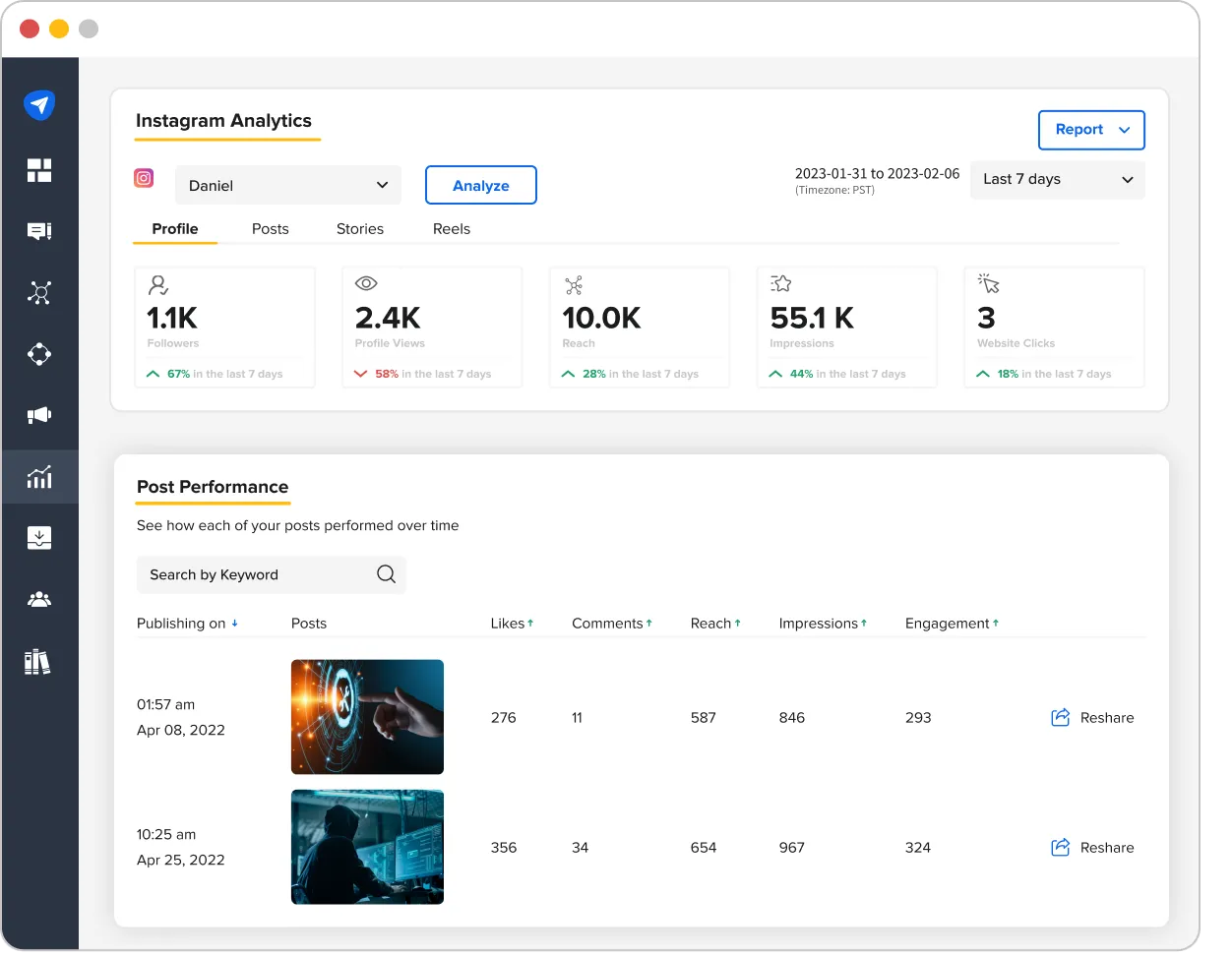Businesses spend a significant chunk of their marketing budget on social media, expecting to see results as soon as possible. It is one of the most effective digital marketing platforms today, with social media ad spending projected to reach more than $234 billion in 2024.
Despite social media marketing’s fast-growing popularity, most marketing agencies fail to measure their clients’ social media ROI. This is one of the primary reasons why most agencies find it challenging to attract and retain clients.
Proving the ROI of your social media efforts enables you to understand the effectiveness of your social media marketing efforts, demonstrate value to the clients, and improve the overall strategy to achieve marketing goals.
Feeling overwhelmed by all this technical jargon?
Don’t worry; we will walk you through the steps to calculate the ROI, what different metrics you should look into, and ways to improve them to drive continuous improvement.
What Is Social Media ROI and Why It Matters?
Social Media ROI (Return on investment) is a performance measure used to determine how much benefit a business is getting from its investments in social media marketing. Whether your goal is to increase brand awareness, drive sales and leads, or increase customer engagement, it gives you insights into all.
For example, if a company spends money on Facebook ads or pays an agency to manage its Instagram account, it wants to know if these actions help it sell more products, attract new customers, or improve its brand visibility.
Here are the top 3 reasons why you should measure social media ROI:
- Enhances campaign effectiveness: By analyzing the ROI, marketers can optimize their campaigns for enhanced performance. This includes refining content, targeting the right target audience, and selecting the most effective platforms.
- Builds stakeholder confidence: Demonstrating a positive ROI can build confidence among your stakeholders and secure ongoing support for social media initiatives. It showcases that social media investments are significantly contributing to the bottom line of the company
- Optimizing spending: Another added advantage of tracking ROI is that companies can easily pinpoint which channels are bringing the most traffic, allowing them to allocate resources more effectively and efficiently.
Now, let’s take a look at how you can calculate it.
How Do You Calculate Social ROI?
Here is the formula to calculate Social Media ROI:
Social Media ROI = Profit/Investment x 100
Profit = The monetary value or money you earn from various social media marketing initiatives
Investment = The cost of all your social media marketing actions
Using this formula makes it simpler to measure ROI for your social media campaigns that can be attributed to a monetary value.
The below image will help you understand different metrics that connect your social media marketing campaigns to ROI at various stages of the buying journey:
When it comes to social media, there are several metrics that play a vital role in tracking the campaign performance. However, you need to know the right metrics to paint a clear picture of the return from social media.
We have discussed 6 metrics that can come in handy.
6 Different Metrics to Measure Social ROI
How you measure social ROI depends on the organization’s objectives, including customer satisfaction, brand awareness, revenue, engagement, etc.
Below is an example of the common metrics that content executives use to measure how the content is performing:

6 Different Metrics to Measure Social ROI
How you measure social ROI depends on the organization’s objectives, including customer satisfaction, brand awareness, revenue, engagement, etc.
Below is an example of the common metrics that content executives use to measure how the content is performing:

1. Conversion Rate
Conversion rates are essential for measuring social ROI as they directly tie to your business goals.
By tracking how many users take a desired action, you can determine the effectiveness of your social media content in driving conversions. This, in turn, helps identify which social media platforms, campaigns, or content types are most effective at driving conversions, allowing you to optimize your social media strategy for better results.
Additionally, tracking conversion rates can help you determine the ROI of your social media marketing efforts and demonstrate the value of social media to your stakeholders.
2. Track Vanity Metrics
Choosing the right metrics is crucial and should align with your objectives to help make better business decisions.
Vanity metrics such as likes, shares, and comments help you assess the campaign’s general success. On the other hand, tangible metrics such as leads generated, website traffic, sign-ups, or conversions can measure the campaign’s monetary value.
Whatever metrics you use, ensure you regularly monitor them. Measure the return on investment over a particular period depending on the sales cycle. Unless your goals, objectives, and metrics are on track, measuring and proving social ROI to your agency clients will be challenging.
3. Social Media Traffic and Followers
Social media traffic and followers are essential metrics to measure social ROI.
The former refers to the number of people visiting your website or landing page through various social media channels. Tracking this metric is crucial to help you understand how effectively your social media content drives traffic to your website, which can ultimately lead to conversions.
On the other hand, the number of followers on your social media channels reflects your brand’s reach and audience engagement. By tracking this metric, you can determine which content resonates with your audience and adjust your strategy to attract more followers and increase engagement.
Doing so also helps identify potential brand advocates who can share your content and help grow your audience.
4. Track Product/Customer Reviews
Reviews are one of the biggest indicators of customer satisfaction levels, often attributed to greater sales and ROI.
According to a study, around 80% customers acknowledge that the experiences that brands provide matter as much as their products and services.
Modern consumers are more informed and expect personalized offers and services. All these factors directly relate to the customer’s brand perception and are reflected in their reviews.
Improved positive reviews are an indicator of enhanced brand loyalty and higher ROI.
Track customer reviews on popular review sites to prove social returns on investment for your clients. Perform thorough research to understand the customers’ quality expectations and demand patterns. This will help you match their expectations to deliverables, determining the satisfaction level.
Monitoring how customers respond to social media marketing actions is crucial. This enables you to understand what’s working with them best and what’s not. Tracking positive customer reviews generated via your social media campaigns can help prove ROI for your clients because it typically reflects higher conversions.
5. Cost Per Acquisition
Cost per acquisition (CPA) is another important metric to track because it helps you understand the ROI of your social media campaigns.
CPA helps you determine the amount you spend on acquiring new customers through your social media marketing efforts. By comparing the CPA across different channels, you can optimize your budget and adjust your social media strategy accordingly. This allows you to allocate your resources toward the channels that offer the best ROI for your business.
To determine the CPA, you need to divide the total cost of your social media campaigns by the number of new customers acquired during that period. This allows you to compare the cost of acquiring customers through different channels and make informed decisions about where to allocate your marketing budget.
This metric can also help you optimize your campaigns by identifying which drives the most conversions at the lowest cost.
6. Brand Sentiment
Brand sentiment measures users’ general attitude or emotion towards your brand on social media platforms. This includes both positive and negative mentions that users make about your brand, products, or services.
Monitoring this metric is vital to help you understand how people perceive your brand and whether they have positive or negative associations with it. Over time, you can identify trends, track the impact of your marketing efforts, and adjust your social media strategy accordingly.
For instance, if you notice a negative trend in brand sentiment, you can address the issues causing negative feedback. This includes improving customer service, addressing product quality concerns, or creating engaging and positive content.
5 Ways to Improve Social Media ROI
Improving your ROI is a long-term game; it needs a clear vision, strategic planning, effective execution, and so much more. Here are some proven ways that you can use to get started:
Set Clear Goals and Objectives
Every social media marketing strategy starts with setting goals. These goals are defined based on the business objectives and give teams a clear vision to work on. Establish clear and measurable goals that align with your overall business objectives.
Whether you want to increase brand awareness, drive website traffic, or generate qualified leads, having defined social media goals will always guide your strategy.
PS: Ensure your goals are SMART (specific, measurable, achievable, relevant, and time-bound). This clarity will help you track progress and better evaluate success.
Identify Your Audience
Identify your target audience’s demographics, interests, behaviors, and pain points. Understand what content they like, what format they want to see the most, and what time of the day they are most active.
This action especially pays off when you are running paid ads, where slight changes can make you miss your goals by miles. Conduct thorough research and develop detailed customer personas to tailor your content to resonate with the audience and drive results.
Take Advantage of Analytics Tools
One of the quickest ways to improve your client’s social ROI is by using a social media management tool like SocialPilot.
SocialPilot lets you easily and quickly track the performance of your social media accounts. You can identify KPIs and find granular engagement metrics like audience demographics, follower growth, reach, engagement, and more.

SocialPilot analytics helps you analyze high-performing posts so you can replicate the same strategies across your content.
Hashtags are something that can help you reach more audience and get discovered easily. With hashtag performance, you can discover which hashtags brought you the most amount of traffic and average engagement rate.
Finally, the reports! SocialPilot lets you generate and download PDF reports with all the crucial metrics and share them with your team and clients always to keep them informed.
Another perk is that you don’t need to remember the dates to send the reports manually; you can schedule the posts and SocialPilot will automatically send it out for you.
Optimize What You Post
If you’re running ads on social media platforms, try experimenting with different ad formats. You can try out various ways to see which delivers the best result. When you provide your clients with the social ROI report, include what you tried out and what worked the best for their social media and audience.
Take UK’s leading gym, PureGym, as an example. They saw a substantial increase of 11% in their memberships after adopting a new approach tailored to the Reels ads format on Instagram and Facebook. Furthermore, there was an 11% decrease in cost per purchase too, in comparison to the previous Reels ads.

Source: PureGYM
Plan for Long-Term
Always remember that social ROI is a long-term goal. So, don’t stress over short-term ROI targets you may not have achieved.
For instance, if you need to jump off a viral trend quickly just to get a bunch of comments and likes that provide your client’s audience with no real value, it could backfire and annoy them. Worse, it could seriously tarnish your brand voice and reputation, too.
Always think of the big picture to prove a positive social ROI to your client. A long-term focus allows agencies to track the impact of their social media efforts and adjust their approach as needed, leading to improved performance and increased ROI for both the agency and its clients.
In short, a long-term focus on social media ROI is essential for building trust and establishing a successful, sustainable partnership with clients.
Conclusion
As a marketing agency, your responsibility is to prove that your social media campaigns are highly effective in delivering higher yields for your client’s investments.
You can prove their social returns on investment by setting clear objectives & measurable goals, building an ROI dashboard, tracking customer reviews, establishing meaningful conversations, and regular reporting.


